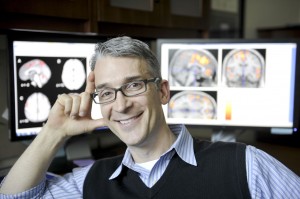
Todd Monroe is on a quest to figure out if and how people with Alzheimer’s disease feel pain.
Thanks to a grant from the John Hartford Foundation and the Atlantic Philanthropies, Vanderbilt University School of Nursing’s Monroe, PhD, RN, is studying women with mild to moderate Alzheimer’s disease and healthy women to see how they respond to thermal pain stimulus. The team uses functional Magnetic Resonance Imaging (fMRI) technology to examine structural changes in the brain and to elucidate the pathways in the brain responsible for the sensory and emotional responses to pain.
After an initial visit and interview with the subject and her caregiver, the subject will travel to Vanderbilt University Medical Center for an fMRI. While in the fMRI machine, a small metal cube that heats up and cools down is attached to the palm of the hand while researchers take pictures of the brain to record the pain pathways.
“We chose the palm of the hand because there are many nerve endings in that region making it a sensitive area good for research. In the current study we are primarily assessing the response to acute pain. First, the sensory information travels to the spinal cord and then to the brain via specific pain pathways. Basically, once the information reaches the brain it is further processed by many brain regions which help the person to rate the level of stimulus sensitivity and unpleasantness,” said Monroe.
Thermal stimulus was chosen to ensure the pain is being delivered systematically and in a standardized manner. Moreover, the nerve fibers evoked by experimental acute thermal pain may one day translate into clinically meaningful findings.
The study subject group is focused on women for several reasons. First, women are considered an under-researched group by the National Institutes of Health. Second, when compared to men, the research literature suggests that women report and/or experience pain more over their lifetime.
“Many nurses may recall learning about pain in physiology classes and the many different types of pain fibers. The most commonly studied fibers are the C-fibers and A-fibers,” said Monroe. “A-fibers are associated with acute pain and C-fibers are associated with chronic pain. In the current study, we hope to look at differences between these two fibers and their associated brain activation patterns. Ultimately structural changes in the brain in people with dementia may create difficulty in communicating. Thus, the person may be suffering but unable to clearly communicate their distress.”
Monroe was drawn to Vanderbilt for his post-doctoral work because VUSN and the Vanderbilt University Institute of Imaging Science (VUIIS), combined, offered a multidisciplinary, collaborative training opportunity.
“I am extremely grateful for the opportunities that both Dean Colleen Conway-Welch and VUIIS Director John Gore have given me here at Vanderbilt.
The support and training that I have received from the School of Nursing’s Senior Associate Dean of Research Ann Minnick, Independence Foundation Professor Lorraine Mion, and the Director of the Vanderbilt Psychiatric Neuroimaging Program Ronald Cowan have provided me with a solid foundation to successfully move forward.”
This study looks at people who can still communicate, but Monroe hopes it will lead to future opportunities for research in advanced, non-communicative dementia patients – much like his own grandmother who died from end-stage Alzheimer’s disease and who also was diagnosed with cancer.
“As nurses, we think about behaviors in people who have difficulty communicating,” said Monroe. “We respond to behaviors. We usually verify behaviors by what the patient tells us. For example, a person may grimace and say ‘that hurts’ – obviously in people who cannot communicate this becomes a challenge. But, to use basic science to help address this challenging question – it’s very gratifying.”
– Kathy Rivers
CONTACT:
The study’s pilot phase has ended and recruitment is under way for the 64 subjects. For more information contact Todd.monroe@vanderbilt.edu